
-
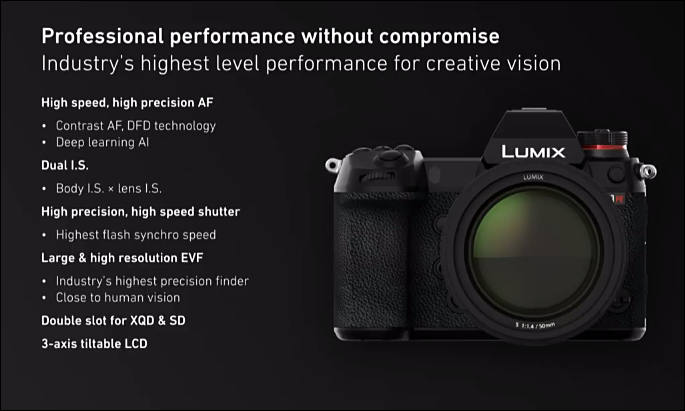
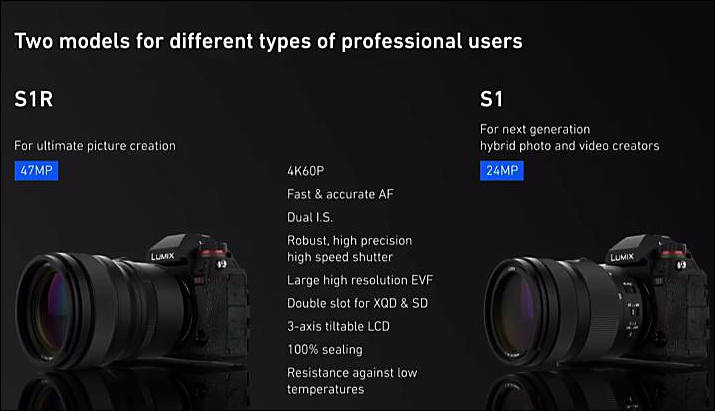
- 24MP Sony made sensor (exactly same as Z6 and A7III)
- 4K 60p/50p video
- Same old DFD contrast only AF
- 3-axis tiltable screen (seems like made for still shooter only)
- Dual slot with one XQD and one SD
- Weatherproof
- EVF has good resolution
- L-mount, partnership with Leica and Sigma
- Top-panel LCD screen that can be backlit
- WB/ISO/EV buttons
- On/Off switch
- Front/rear control dials
- Lockable shooting mode dial, with t PASM modes, C1,2,3 modes and iA mode
- Drive mode dial underneath the shooting mode dial *A / S/C/MF dial which surrounds the AF point button
- On the rear
- Lock button on the left
- Playback button
- Movie record button,
- AF On, AF Joystick
- Quick menu button
- Circular scroll wheel
- Menu/set button
- Back button
- Display button
- Delete button
- Function buttons on the front of the camera, and a 1/2 switch
- V.mode button
-
PR
Panasonic Corporation has developed two models of its first Digital Single Lens Mirrorless camera with a 35 mm full-frame image sensor, the LUMIX S1R and the S1. These models are equipped with the world's first^*1^ 4K 60p video recording function and the Dual I.S. image stabilization system. As part of the LUMIX S series, Panasonic aims to release them on the global market early 2019.
For 100 years since its founding, Panasonic has strived to help realize better lives for customers around the world by responding to their needs. Working on the concept of creating a new culture of photography for a digital age with digital cameras, in 2008 Panasonic released the LUMIX G1, the world's first^2^ Digital Single Lens Mirrorless camera. Over the ten years since then, Panasonic has continued to lead the industry with product innovations, such as the world's first^3^ camera supporting 4K video recording, and cameras equipped with the Dual I.S. (Image Stabilization) system, combining stabilization both inside the camera unit and the lens.
In recent years, telecommunications lines have increased in speed while social media video-sharing has gained popularity and as a result, more and more people are enjoying a hybrid of photos and videos, widening the range of expression in content production. This new field prompted the need for a new type of camera that goes beyond the boundaries of traditional photos and videos.
With this in mind, Panasonic adopted the concept, 'Fuel the Photographers' Creative Vision' to develop a Digital Single Lens Mirrorless camera with a strong focus on the expressive capabilities for both photos and videos. The company will bring these cameras to market as part of the LUMIX S series, striving to provide "specialized value" to customers desiring higher expressiveness. The cameras are user-friendly and offer a robust assortment of essential tools for professional photography and videography, as well as incorporate an entire array of Panasonic technology refined over a century. The latest innovations in Lumix S series also build on Panasonic's ten years' experience developing Digital Single Lens Mirrorless cameras, including digital technology such as image or signal processing, plus optical and heat dispersion technology and more. The combination of these capabilities will provide customers with new value for photography and videography.
The key features of the newly developed cameras, the LUMIX S1R and the S1, are as follows.
Capabilities with high definition and high level of expression achieved with the newly-developed 35 mm full-frame image sensor and image processing engine.
Effective pixels: approximately 47M for the S1R and 24M for the S1.
- World's first support for 4K 60p video recording in a full-frame Digital Single Lens Mirrorless camera.
- World's first full-frame camera equipped with Dual I.S. (Image Stabilization), enabling handheld shots for dark or distant scenes that would previously have required a tripod or other equipment.
- A double slot for XQD memory cards and SD memory cards, the first for Panasonic; and a rugged triaxial tilt LCD, emphasizing ease of use and supporting professional photography and videography.
- Leica Camera's L-Mount, making it possible to use interchangeable lenses that meet the L-Mount specifications of the partners Leica Camera and Sigma. Expressiveness is further enhanced by increasing options for interchangeable lenses.
Panasonic will also expand its lineup of LUMIX S series compatible lenses, developing more than ten by 2020, including a 50 mm/F1.4 fixed-focus lens, 24-105 mm standard zoom lens, and 70-200 mm telephoto zoom lens.
In addition, Panasonic has announced the launch of LUMIX PRO, a service and support program for its LUMIX professionals. This program has been designed to ensure that professionals can receive service and repair benefits globally. Stay tuned for additional details on the October launch for the US market.
The LUMIX GH5, G9, and GH5S high-end Digital Single Lens Mirrorless cameras that Panasonic released since 2017 have already gained a solid reputation among professionals and high-level amateurs across the world for the quality of their pictures and ability to capture the vitality and beauty of life. This success is owed to Panasonic's world-first^6^ support for 4K 60p/50p video recording, and the world's fastest autofocus^7^ function using the company's proprietary DFD (Depth From Defocus) technology. Panasonic will continue to provide new value to customers through the unique features of the compact, yet high-definition, LUMIX G series, while also reaching the professional market through the introduction of the full-frame LUMIX S series and the greater reach of the company's support system. Through these measures, Panasonic will help to create a new culture of photography and videography.
Prototypes of the new cameras and lenses introduced above will be exhibited at Photokina 2018.
-
The company says the 24MP S1 is expected to be used around 70% for stills and 30% for video, targeting people such as wedding photographers and photojournalists.
-
30% video buyers is a lot for a stills camera. Has any stills camera exceeded this before other than GH5S and a7S?
-
Yes, Panasonic GH lineup.
-
Interesting design for the LCD screen: https://www.slashcam.de/images/news/PanasonicS1R_display-14634_PIC3.jpg
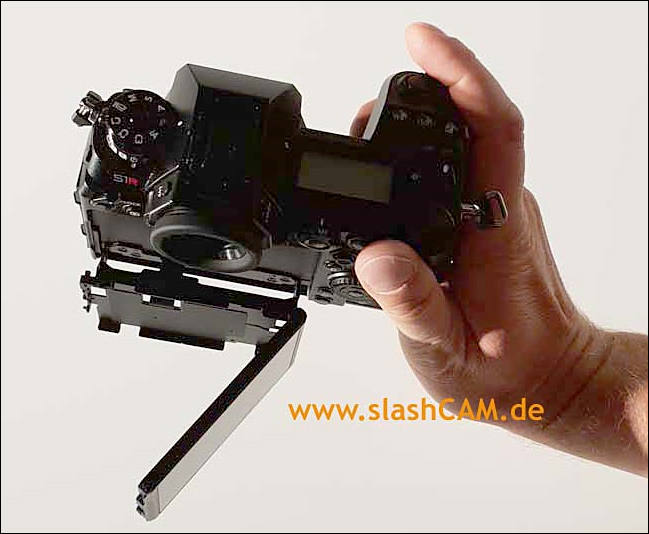

 sa4799.jpg649 x 534 - 44K
sa4799.jpg649 x 534 - 44K -
"The company says the 24MP S1 is expected to be used around 70% for stills and 30% for video, targeting people such as wedding photographers and photojournalists."
They might have said that but I find it very inconsistent with what was said during the press announcement. Watch the video again from the 12.58min point to when he starts talking about lenses. I don't doubt that will not be a very highly capable stills and video camera. What I don't know yet (I guess will find out when it comes out) is how good their "new" DFD technology with Ai will stand up with the links of Canon, Sony and yet to be seen Z6.
-
Design looks like some of the top managers became very drunk and made at the morning...
-
The sensor might be the same as Sony's A7III, but now the question is how the S1 will compare to A7III in price, how the new L-mount lenses quality and price will compare against sony E-mount lenses. The S1 will be better for video, of course, but more pricey I suppose. I was about to buy a Sony A7III, and maybe I will.
-
It is all about the margins now.
Plus account that Sony gets sensors at manufacturing cost and Panasonic for price with big margins included.
-
It would be pretty difficult to make lenses with substantially higher quality than the current lineup of Sony lenses (although I think that they're a little bit soulless, that's pretty hard to quantify) and I doubt Panasonic's intention is to compete with them on price. Until the SL lens lineup is fleshed out a bit, unless you have tens of thousands to invest in Leica's SL lenses, Sony is the much better investment if you're actually planning to use your camera.
(And hopefully the availability of 4kp60 on this camera is enough to finally push them to release the a7s3)
-
well I think that is why the sigma partnership is an important one as they can pump out relatively cheap lenses or adapt their existing ones
-
Sure, though "You can use the same Sigma lenses that are available for other mounts" is not a compelling argument in favor of purchasing a given camera system. :)
-
Sigma will do primary their primes and will avoid making any lenses that conflict with Leica or Panasonic.
All in all it'll be system with lack of good affordable lenses. And with extreme risk of cancelling.
Internally Panasonic is ready to kill it all in case it won't fly good. Same as m43.
-
It seems like issue with screen is big one
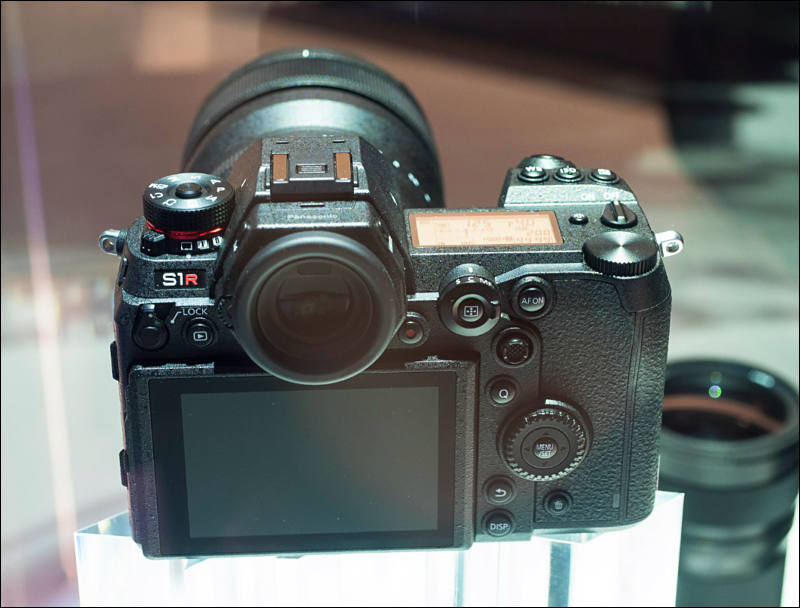
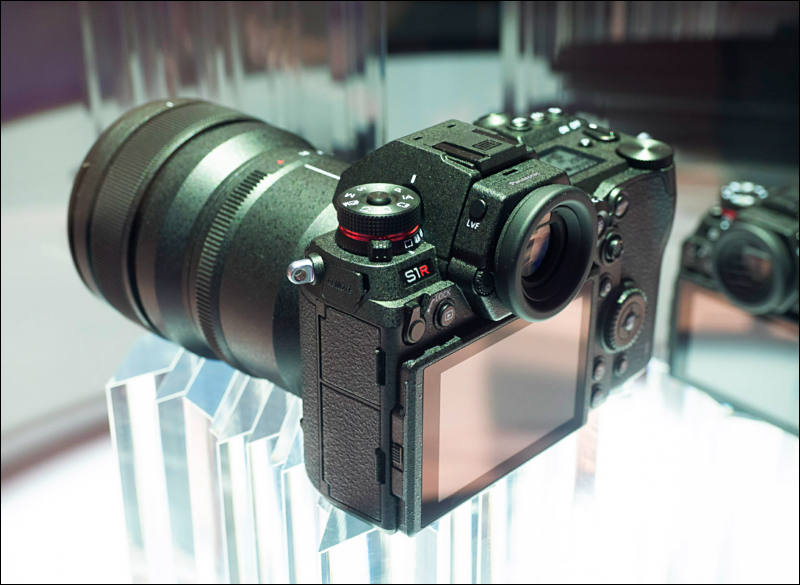
-
Now I see exactly ZERO reasons to wait for this body.
-
Some tell that screen is ala T100
But it does not look like this at all, look slashcam photo above.
-
I just wish they'd made the dial on the left a little taller. It doesn't stick out enough yet - maybe another 1.5x taller and they'd really have an attractive camera.
-
Frankly, I like the ergonmics and the buttons more than the Nikon Z6/Eos R, they all seem to be thoughtfully designed, the lever is really useful.
-
It is not a T100 screen (unfortunately), it is a XT-3 like screen.
-
Yes.
As I told from the start - it is camera made for still shooters.
Very rich still shooters.
It is big reason why Panasonic did not announce any prices.
Panasonic still needs video to set themselves slightly apart.
But it will be not good choice for video shooter.
-
Jesus, what did they use to "3D Print" that pathetic camera body? It looks like something you'd find in a junk shop!
-
Same place they used to print GH mockups :-)
-
About prices
Sony A7 III and A7R III cost $2,000 and $3,200, respectively.
Canon's Z6 and Z7 cost $2,000 and $3,600
Canon EOS R is $2,299Leaks of internal talks in Panasonic - $2999 for S1 and $3999 for S1R. It is no way set prices. But top management wishes. Bottom numbers could be $2599 and $3499 if market research show bad response.
Present response had been bad surprise for marketing team, very cold, hard questions.
They talk on exhibition that none of top managers knew about importance of foldable screen for video and cared. In same time managers assumed that 4K 60fps is highly wished feature and they could add big premium to price compared to competition.Lenses prices are current planned as Canon EOS R price + 10-15% more. In other words - highest prices in industry. Panasonic have no plans to have any budget lenses made until 2022.
Next leak is that EVF optics will be very good, but resolution can be standard as in Nikon or Sony cameras, presently no better OLED screen is made. This is why it is so fuzzy, Panasonic most probably will put same old screen, but they have elusive hope that mass production of new prototype screens will ramp up.
Howdy, Stranger!
It looks like you're new here. If you want to get involved, click one of these buttons!
Categories
- Topics List23,997
- Blog5,725
- General and News1,359
- Hacks and Patches1,153
- ↳ Top Settings33
- ↳ Beginners256
- ↳ Archives402
- ↳ Hacks News and Development56
- Cameras2,367
- ↳ Panasonic995
- ↳ Canon118
- ↳ Sony156
- ↳ Nikon96
- ↳ Pentax and Samsung70
- ↳ Olympus and Fujifilm101
- ↳ Compacts and Camcorders300
- ↳ Smartphones for video97
- ↳ Pro Video Cameras191
- ↳ BlackMagic and other raw cameras116
- Skill1,960
- ↳ Business and distribution66
- ↳ Preparation, scripts and legal38
- ↳ Art149
- ↳ Import, Convert, Exporting291
- ↳ Editors191
- ↳ Effects and stunts115
- ↳ Color grading197
- ↳ Sound and Music280
- ↳ Lighting96
- ↳ Software and storage tips266
- Gear5,420
- ↳ Filters, Adapters, Matte boxes344
- ↳ Lenses1,582
- ↳ Follow focus and gears93
- ↳ Sound499
- ↳ Lighting gear314
- ↳ Camera movement230
- ↳ Gimbals and copters302
- ↳ Rigs and related stuff273
- ↳ Power solutions83
- ↳ Monitors and viewfinders340
- ↳ Tripods and fluid heads139
- ↳ Storage286
- ↳ Computers and studio gear560
- ↳ VR and 3D248
- Showcase1,859
- Marketplace2,834
- Offtopic1,320






